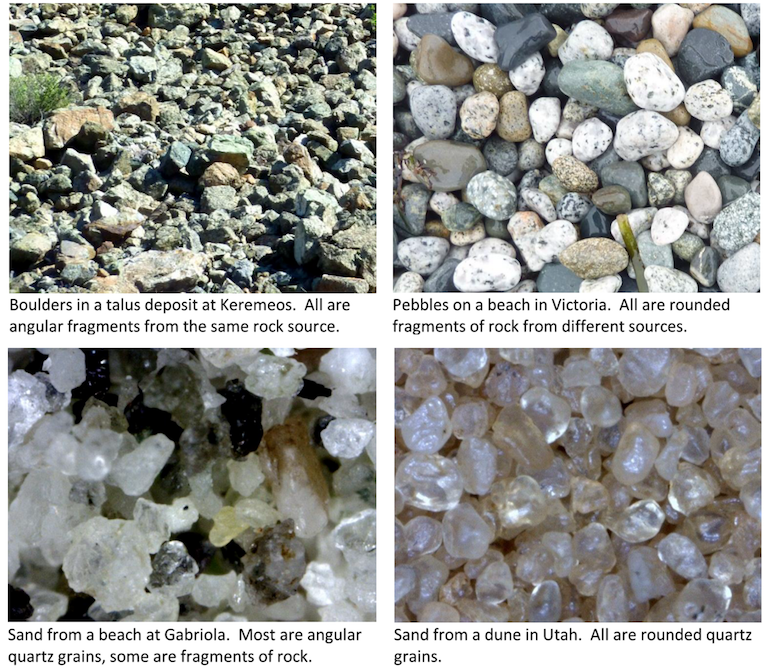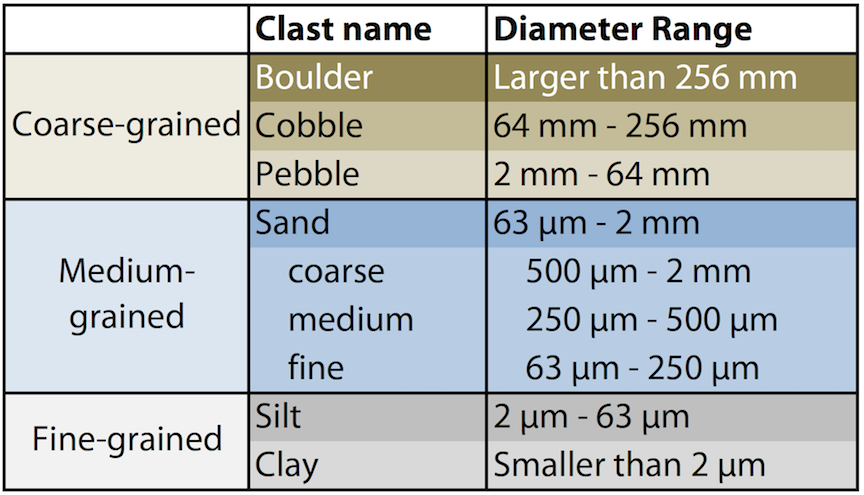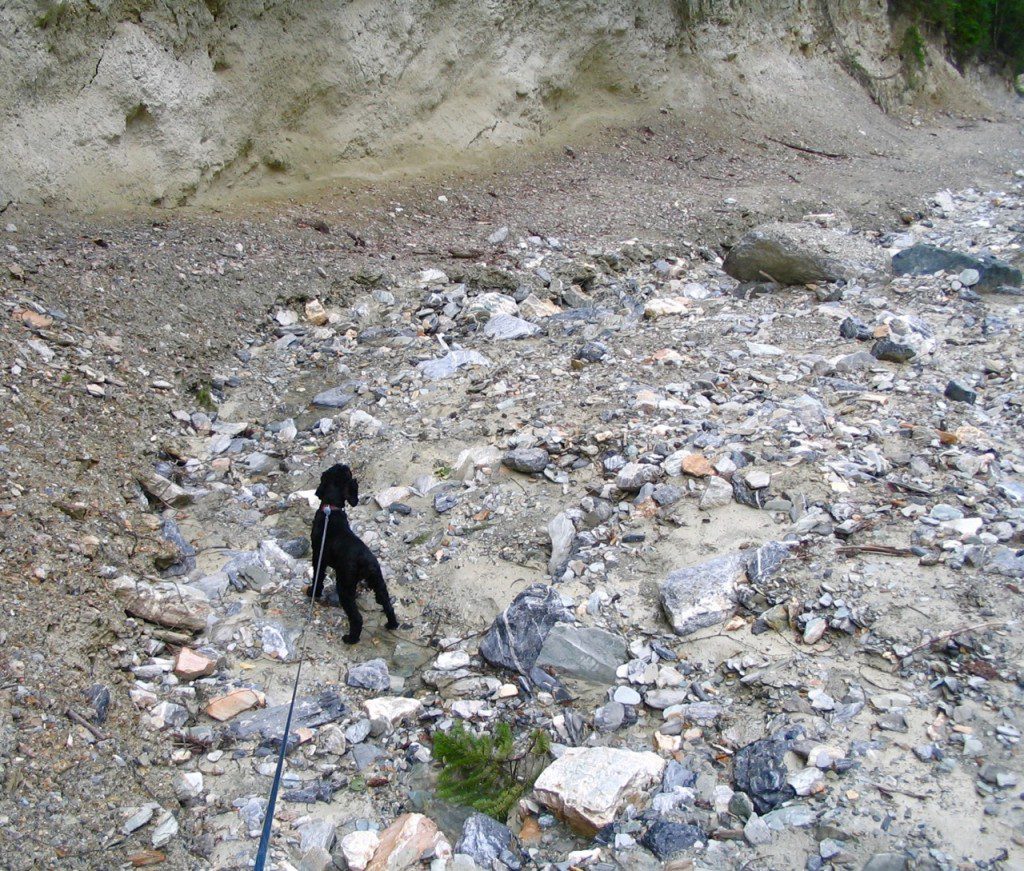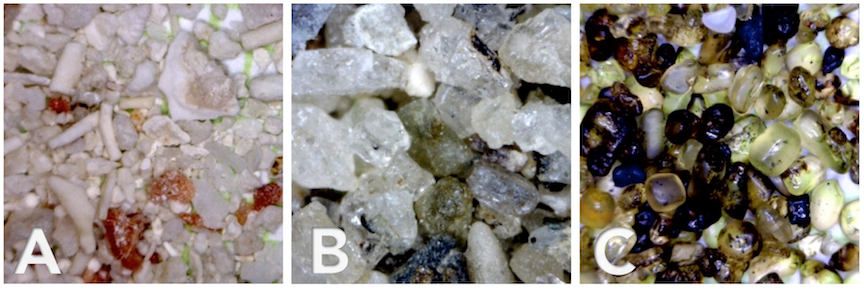8.4 Weathering and Erosion Produce Sediments
The visible products of weathering and erosion are the unconsolidated materials that we find around us on slopes, beneath glaciers, in stream valleys, on beaches, and in deserts. The loose collection of material is referred to as sediment, and the individual pieces that make it up are called clasts. Clasts can be of any size: sand-sized and smaller (in which case they might be referred to as particles or grains), or larger than a house.
Clasts can range widely in size and shape (Figure 8.16) depending on the processes involved in making and transporting them. If and when deposits like these are turned into sedimentary rocks, the mineralogy and textures of these rocks will vary significantly. Importantly, when we describe sedimentary rocks that formed millions of years in the past, we can study the mineralogy and textures to make inferences about the conditions that existed during the deposition of the sediment, and the later burial and formation of sedimentary rock. The properties we look at are composition, grain size, sorting, rounding, and sphericity.

Composition
Composition refers to the mineral or minerals making up the clast. Small clasts might be single mineral grains, but larger ones can have several different mineral grains, or even several different pieces of rock within them. The composition can tell us about what rock the sediments came from, and about the geological setting from which the sediment was derived.
Not all minerals have the same hardness and resistance to weathering, so as weathering and erosion proceed, some minerals become more abundant than others within sediments. Quartz is one example of a mineral that is more abundant. It is highly resistant to weathering by weak acids or reaction with oxygen. This makes it unique among the minerals that are common in igneous rocks. Quartz is also very hard, so it is resistant to mechanical weathering.
In contrast, feldspar and iron- and magnesium-bearing minerals are not as resistant to weathering. As weathering proceeds, they are likely to be broken into small pieces and converted into clay minerals and dissolved ions. Ultimately this means that quartz, clay minerals, iron oxides, aluminum oxides, and dissolved ions are the most common products of weathering.
Grain Size
Whether a grain is large or small tells us about its journey from its source to where it was deposited. Mechanical weathering can break off large pieces from rock. Large pieces carried along by streams will bump into each other, causing smaller pieces to break off. Over time the grains get smaller and smaller still. If we find grains that are very small, we can conclude that they travelled over a long distance.
Geologists have a specific set of definitions to describe the size of grains (Figure 8.17).

The scale has some of the grain sizes listed in microns (µm). There are 1000 µm in 1 mm. The particles classified as sand are what you would intuitively think of as being sand-sized, so an easy way to remember the scale is that anything smaller than sand is fine-grained, and anything larger is coarse-grained. Fine sand grains are still easily discernible with the naked eye. Silt grains are barely discernible in rocks, and silty rocks feel gritty when rubbed. Clay grains are invisible to the naked eye, and rocks comprised of clay feel smooth when rubbed.
One other thing to notice about this scale is that the finest-grained particle is referred to as clay. While a clay-sized particle could be composed of clay minerals (and often they are), it doesn’t have to be. Any particle of that size would be referred to as clay.
Grain Size and Transportation
The grain size of sediments is not just for purposes of description. It’s also a valuable clue to the processes that have acted on those sediments, because the size of the clast determines how much energy is required to move it.
Whether or not a medium such as water or air has the ability to move a clast of a particular size and keep it moving depends on the velocity of the flow. For the most part, the faster the medium flows, the larger the clasts that can be moved. Figure 8.18 shows a stream bed that now contains only a trickle of water—barely enough to move particles of sand or cool puppy feet. But the velocity of water in the stream changes from season to season, as does the volume of water. All of the clasts in the stream bed were transported there by water at some point.

Very fine-grained particles are the exception to rule that the larger the clasts, the faster the water that is required to transport them. Clay and silt grains stick together, requiring higher water velocities to pick them up and move them than some larger particles. Water that flows fast enough to pick up sand would not be fast enough to pick up clay.
Sorting
Weathering can break off large fragments of rock, and erosion and transport can break these fragments down to smaller and smaller sizes. The extent to which the grains in sediment differ in size is described by sorting (Figure 8.19, top).

If the grains in a sample of sediment are the same size or very nearly so, the sediment is said to be well sorted. If the grains vary substantially in size, the sediment is poorly sorted. Because grains become progressively smaller as they are transported, sorting improves the further the sediments are from their source.
Rounding
Rounding refers to whether clasts have sharp edges and corners or not (Figure 8.19, bottom). If the grains are rough, with lots of edges and corners, then they are referred to as angular. Grains with smooth surfaces are rounded. Grains in between can be sub-angular or sub-rounded. The farther sediments are transported, the rounder they become.
Sphericity
Sphericity describes whether a grain is elongate or not. Grains that are longer than they are wide (like an ellipse) have low sphericity, whereas grains that have the same diameter no matter where you measure it (like a sphere) have high sphericity. In the bottom row of boxes in Figure 8.19 the grains at the top of each box exhibit high sphericity, and the grains at the bottom exhibit low sphericity. Notice that a grain can be angular but still have high sphericity. It can be rounded, but still have low sphericity. Sphericity also increases the further the sediments are from their source.
Exercise: Looking at Sand
Three samples of sand are shown below. Read the descriptions of what they contain and where they are from, then describe each sample in terms of grain size, sorting, rounding, and sphericity.

Sample A: Fragments of red coral, algae plates, and urchin needles from a shallow water area (~2 m depth) near a reef in Belize. The grains are between 0.1 and 1 mm across.
Sample B: Quartz and rock fragments from a glacial stream deposit near Osoyoos, BC. The grains are between 0.25 and 0.5 mm in diameter.
Sample C: Grains of olivine (green) and volcanic glass (black) from a beach on the big island of Hawai’i. The grains are approximately 1 mm in diameter.
References
Reagan, M.K., Pearce, J.A., Petronotis, K., and the Expedition 352 Scientists, (2015). Proceedings of the International Ocean Discovery Program, Volume 352, publications.iodp.org, doi:10.14379/iodp.proc.352.102.2015

